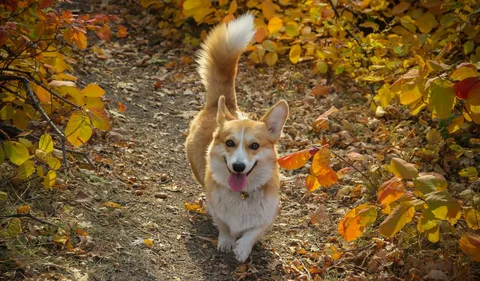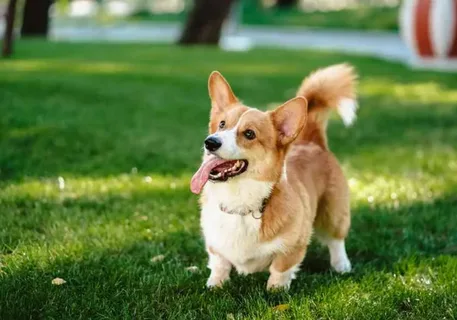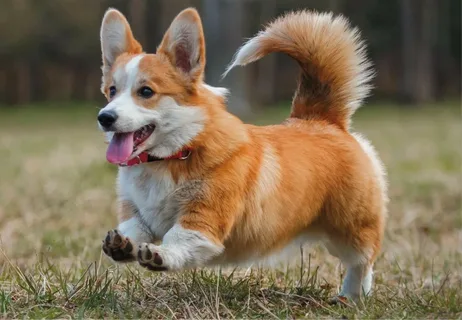Corgi With Tail its 10 Adorable Facts
kifayatullahmohmand997@gmail.com
Corgi With Tail its 10 Adorable Facts
Corgis are one of the most beloved dog breeds worldwide, and they are known for their prominent personalities and adorable short legs. But there’s one feature that often surprises people: corgis with tails! While many associate corgis with a tailless look, many Pembroke Welsh Corgis have tails, and Cardigan Welsh Corgis almost always do. Let’s explore the world of tailed corgis with these ten adorable and fascinating facts.
Table of Contents
Corgis Are Naturally Born With Tails
Believe it or not, all corgis are born with tails. Most Pembroke Welsh Corgis, the breed often seen without tails, have traditionally had their tails docked shortly after birth. This practice started because Pembrokes were working dogs, herding cattle, and tail docking helped prevent injuries. In contrast, Cardigan Welsh Corgis, the other type of corgi, usually keep their long tails since they have different breed standards and were bred in various regions of Wales.

Cardigan Welsh Corgis Always Have Tails
One easy way to tell the difference between a Pembroke and a Cardigan Corgi is the tail. With their broader chests and slightly longer frames, Cardigan Corgis typically keep their tails intact. Their tails are naturally long and bushy and often look like a fox’s tail. So, if you see a corgi with a long, flowing tail, it’s likely a Cardigan!
More Pembroke Corgis Are Keeping Their Tails
Today, there’s a growing trend of leaving Pembroke Corgi’s tails undocked. This shift is partly due to changing attitudes toward tail docking and a preference for keeping dogs in their natural state. In some countries, tail docking is restricted or banned for cosmetic reasons, leading more Pembrokes to sport their cute, fluffy tails.

Corgi Tails Look Like Fox Tails
When corgis do have tails, they’re genuinely adorable! A natural corgi tail is often bushy, fluffy, and a bit curled, resembling a fox’s tail. This adds charm, as the tail adds a soft, flowing touch to their look. Many people find the fox-like appearance of a corgi tail incredibly endearing and unique.
Corgi Tails Are Great for Communication
Did you know that dogs use their tails to communicate? Corgis with tails have a slight advantage in expressing their feelings. When a corgi wags its tail, it can signal happiness, excitement, or friendliness. A low-hanging or tucked tail might mean the corgi feels nervous or unsure. Tailed corgis can communicate more clearly with humans and other dogs through tail movements.
Tails Help With Balance
A tail can be incredibly helpful for balance, especially for active dogs. Corgis, especially Cardigans, are skilled herding dogs, and a tail helps them balance while running, turning quickly, or jumping around. While Pembroke Corgis might not need the tail for balance as much in modern settings, a natural tail can still support their agility and movements.

Tailed Corgis Have Unique Personality
Every dog has a unique personality, and for corgis with tails, that uniqueness often shines through their tail’s appearance and carriage. Some corgi tails are curled tightly over their backs, while others may have a more relaxed or slightly arched tail. Each tail style gives the dog a bit of extra personality, making it easier to spot individual differences and quirks in each tailed corgi.
Tail Care is Important for Tailed Corgis
Keeping a natural tail means that owners must be aware of primary tail care. Because corgi tails are often fluffy, they may attract dirt, especially if the dog loves to explore the outdoors. Owners should regularly check for any knots, tangles, or dirt build-up. It’s also important to watch for any signs of tail injury since active dogs sometimes injure their tails through vigorous play.
Tail Docking Laws Are Changing
Tail docking is now restricted or banned in many countries unless medically necessary. These laws reflect a growing trend toward more humane treatment of animals, encouraging people to keep dogs in their natural state. For example, tail docking is prohibited for cosmetic purposes in the United Kingdom, Australia, and several European countries. As more areas adopt these restrictions, we will likely see even more Pembroke Corgis with tails.”corgi with tail“

Tailed or Tailless, Corgis Are Irresistibly Lovable
Whether a corgi has a tail or not, their charm and affectionate nature remain the same. Corgis are known for being loyal, playful, and excellent companions, regardless of their tail status. A tail might make a corgi even more expressive, but all corgis are just as lovable and energetic at heart. Cardigans and Pembrokes are fantastic pets with unique traits and appearances.
Conclusion
Corgis with tails are adorable and add a unique twist to this beloved breed’s appearance. While the tail doesn’t change their lively, loyal personalities, it can enhance their communication, balance, and charm. As tail docking practices evolve, we see more tailed Pembroke Corgis joining their Cardigan counterparts and proudly sporting their natural tails. So whether you love the classic, tailless Pembroke look or prefer a tailed corgi with a fox-like tail, both make incredible, lovable pets.
F.A.Q.s
Q: Are all corgis born with tails?
Yes, all corgis are naturally born with tails. However, it’s common for Pembroke Welsh Corgis to have their tails docked early in life, while Cardigan Welsh Corgis generally keep their tails.
Q: Why are some corgis tailless?
Historically, Pembroke Corgis had their tails docked for practical reasons, like avoiding injuries while herding. Today, tail docking is often done to meet breed standards or for aesthetic reasons, though it’s becoming less common.
Q: Are tailed Pembroke Corgis common?
Tailed Pembrokes are becoming more popular, especially in countries with laws against cosmetic tail docking. Many people also choose to leave Pembrokes undocked for a natural look.
Q: How do I tell a Pembroke from a Cardigan Corgi?
A quick way to tell the difference is by looking at their tails. Cardigan Corgis almost always have long, fluffy tails, while Pembrokes often have docked tails. Cardigans also have slightly longer bodies and broader chests.
Q: Does a corgi’s tail affect its personality?
Not really! Whether a corgi has a tail or not, it remains loyal, friendly, and playful. However, a tailed corgi is expressive with its tail movements.
Q: Do corgis with tails need extra grooming?
Tailed corgis might need extra grooming, especially if they have a long, fluffy tail that can pick up dirt or debris. Regular brushing can help keep their tail clean and tangle-free.




Write a Comment